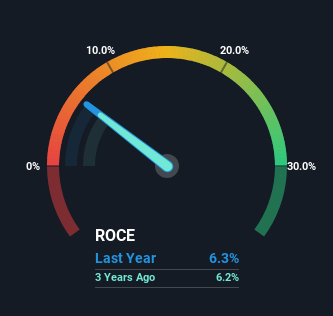The Returns On Capital At SUNeVision Holdings (HKG:1686) Don't Inspire Confidence
There are a few key trends to look for if we want to identify the next multi-bagger. One common approach is to try and find a company with returns on capital employed (ROCE) that are increasing, in conjunction with a growing amount of capital employed. Ultimately, this demonstrates that it's a business that is reinvesting profits at increasing rates of return. However, after investigating SUNeVision Holdings (HKG:1686), we don't think it's current trends fit the mold of a multi-bagger.
Understanding Return On Capital Employed (ROCE)
For those who don't know, ROCE is a measure of a company's yearly pre-tax profit (its return), relative to the capital employed in the business. The formula for this calculation on SUNeVision Holdings is:
Return on Capital Employed = Earnings Before Interest and Tax (EBIT) ÷ (Total Assets - Current Liabilities)
0.063 = HK$1.2b ÷ (HK$21b - HK$2.0b) (Based on the trailing twelve months to June 2023).
Therefore, SUNeVision Holdings has an ROCE of 6.3%. On its own that's a low return on capital but it's in line with the industry's average returns of 6.3%.
See our latest analysis for SUNeVision Holdings

In the above chart we have measured SUNeVision Holdings' prior ROCE against its prior performance, but the future is arguably more important. If you'd like, you can check out the forecasts from the analysts covering SUNeVision Holdings here for free.
So How Is SUNeVision Holdings' ROCE Trending?
On the surface, the trend of ROCE at SUNeVision Holdings doesn't inspire confidence. Around five years ago the returns on capital were 12%, but since then they've fallen to 6.3%. Although, given both revenue and the amount of assets employed in the business have increased, it could suggest the company is investing in growth, and the extra capital has led to a short-term reduction in ROCE. And if the increased capital generates additional returns, the business, and thus shareholders, will benefit in the long run.
The Bottom Line On SUNeVision Holdings' ROCE
While returns have fallen for SUNeVision Holdings in recent times, we're encouraged to see that sales are growing and that the business is reinvesting in its operations. These growth trends haven't led to growth returns though, since the stock has fallen 24% over the last five years. As a result, we'd recommend researching this stock further to uncover what other fundamentals of the business can show us.
One more thing: We've identified 2 warning signs with SUNeVision Holdings (at least 1 which doesn't sit too well with us) , and understanding these would certainly be useful.
While SUNeVision Holdings may not currently earn the highest returns, we've compiled a list of companies that currently earn more than 25% return on equity. Check out this free list here.
New: Manage All Your Stock Portfolios in One Place
We've created the ultimate portfolio companion for stock investors, and it's free.
• Connect an unlimited number of Portfolios and see your total in one currency
• Be alerted to new Warning Signs or Risks via email or mobile
• Track the Fair Value of your stocks
Have feedback on this article? Concerned about the content? Get in touch with us directly. Alternatively, email editorial-team (at) simplywallst.com.
This article by Simply Wall St is general in nature. We provide commentary based on historical data and analyst forecasts only using an unbiased methodology and our articles are not intended to be financial advice. It does not constitute a recommendation to buy or sell any stock, and does not take account of your objectives, or your financial situation. We aim to bring you long-term focused analysis driven by fundamental data. Note that our analysis may not factor in the latest price-sensitive company announcements or qualitative material. Simply Wall St has no position in any stocks mentioned.
About SEHK:1686
SUNeVision Holdings
An investment holding company, provides data centre and information technology (IT) facility services in Hong Kong.
Reasonable growth potential and fair value.
Market Insights
Community Narratives



